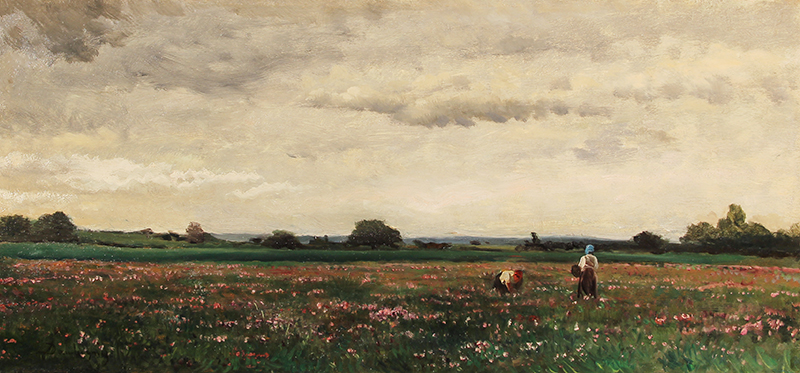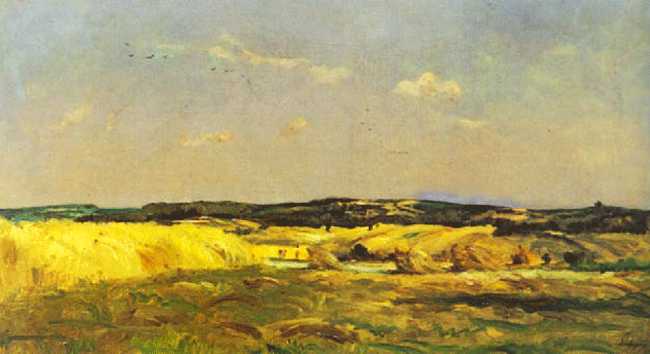CHARLES FRANÇOIS DAUBIGNY PAINTINGS FOR SALE & BIOGRAPHY
CHARLES FRANÇOIS DAUBIGNY
French, 1817–1878
BIOGRAPHY
Charles François Daubigny was born into a family of painters - his father was a landscape painter who had studied with Bertin (a classical landscapist). He himself would pass the tradition onto his son Karl (1846–1886). As a child, Daubigny was raised in Valmandois northwest of Paris, where he would later make his own home. His initial studies were with his father and the animal-landscape painter Brascassat, and he painted on his own at Saint-Cloud and the Forest of Fontainebleau.
At 19 he embarked on a year's travel in Italy, the standard training for a conventionally ambitious artist loyal to the classical tradition. In 1837 he enrolled briefly in the studio of the history painter Paul Delaroche (where Millet was also a pupil) and participated in the initial competitions for the Prix du Paysage Historique.
Although he began exhibiting landscapes at the Salon as early as 1838, Daubigny supported himself well into the 1850s as an illustrator, providing wood engravings for magazines and song sheets. He spent the summer of 1844 in Barbizon but the following year he worked at L'Isle-Adam and Valmandois, beginning a long association with the river-crossed landscape around Pontoise. By 1846 he had established friendships with Rousseau and Dupré who were then painting at L'Isle-Adam; and his own landscapes were becoming more naturalistic. By 1851 he knew Corot, later his closest professional friend. In the 1850s, Daubigny's landscapes began to achieve popular success, although many critics never became comfortable with his broad paint handling, which was often criticized as sketchy and unfinished. Daubigny traveled regularly through France, frequenting the Normandy coast as well the Dauphiné in the south.
In 1857, he was named to the Legion of Honor in recognition of the Salon success of Springtime (Paris, Musée d'Orsay), a government commission. That same year he launched his specially outfitted studio-boat, the 'Botin,' which allowed him to travel easily along the Oise and its many small tributaries, painting riverbanks and river bends from a unique vantage. During the 1860s he exhibited in London, Brussels, and Antwerp and began to win significant commercial success. Elected to the Salon Jury in 1865 and 1868, Daubigny used his position to argue on behalf of younger artists, including Pissarro and Boudin. In London during 1870–71 he introduced Monet and Pissarro to his own dealer, Paul Durand-Ruel; and later he met Cézanne, whose sketches he admired. In 1875 ill health began to restrict his travel. Daubigny died in 1878.
Museum Collections:
Stedelijk Museum, Amsterdam
Musée Daubigny, Auvers-sur-Oise
Musée Bonnat, Bayonne
Musée des Beaux-Arts - Hôtel Fabregat, Béziers
Musée des Beaux-Arts, Bordeaux
Musée Condé, Chantilly
Musée des Beaux-Arts, Chartres
Detroit Institute of Arts, Detroit, MI
Musée Magnin, Dijon
Ateneum Art Museum, Helsinki
Museum of Modern and Contemporary Art, Liège
Musée des Beaux-Arts, Lille
National Gallery, London
Musée des Beaux-Arts, Lyon
Musée Grobet-Labadié, Marseille
Minneapolis Institute of Art, Minneapolis, MN
Musée des Beaux-Arts, Montreal
Tretyakov Gallery, Moscow
Musée des Beaux-Arts, Nantes
Metropolitan Museum of Art, New York, NY
Musée du Louvre, Paris
Musée d'Orsay, Paris
Museum Camille Pissarro, Pontoise
Portland Museum of Art, Portland, OR
Musée des Beaux-Arts, Rheims
Musée des Beaux-Arts, Rouen
California Palace of the Legion of Honor, San Francisco, CA
Hermitage Museum, St. Petersburg
Rijksmuseum, Amsterdam
National Gallery of Art, Washington, DC
Mark Murray Fine Paintings is a New York gallery specializing in buying and selling 19th century and early 20th century artwork.
Please contact us if you are interested in selling your Charles-Francois Daubigny paintings or other artwork from the 19th century and early 20th century.
CHARLES FRANÇOIS DAUBIGNY
Paintings for sale
Currently there are no available Charles François Daubigny paintings for sale at the Mark Murray Gallery.
Please contact us if you are interested in selling your Charles François Daubigny paintings or other artwork from the 19th century and early 20th century.
Charles François Daubigny Paintings Previously Sold
CHARLES FRANÇOIS DAUBIGNY
La Barque au bord de la Rivière
Oil on cradled panel
13½ x 23 inches (34.3 x 58.4 cm)
SOLD
CHARLES FRANÇOIS DAUBIGNY
Les Bords de l'Oise, Ile de Vaux
Oil on canvas
21 x 43¾ inches (53.3 x 111 cm)
SOLD
CHARLES FRANÇOIS DAUBIGNY
Marée Basse (Villerville)
Oil on cradled Panel
10 x 17¼ inches (25.5 x 44 cm)
SOLD
CHARLES FRANÇOIS DAUBIGNY
The River Meuse at Dordrecht (1872)
Oil on canvas
18¼ x 32¼ inches (46.4 x 81.9 cm.)
SOLD
Additional Charles François Daubigny Paintings Previously Sold
CHARLES FRANÇOIS DAUBIGNY
Bord de Rivière
Oil on panel
13½ x 22 inches (34.3 x 55.9 cm)
SOLD
CHARLES FRANÇOIS DAUBIGNY
The Harvest
Oil on canvas
17 x 32 inches (44.6 x 81.5 cm)
SOLD
CHARLES FRANÇOIS DAUBIGNY
Un Verger à La Bonneville (1873)
Oil on canvas
14 x 23 inches (35.6 x 58.4 cm.)
SOLD









